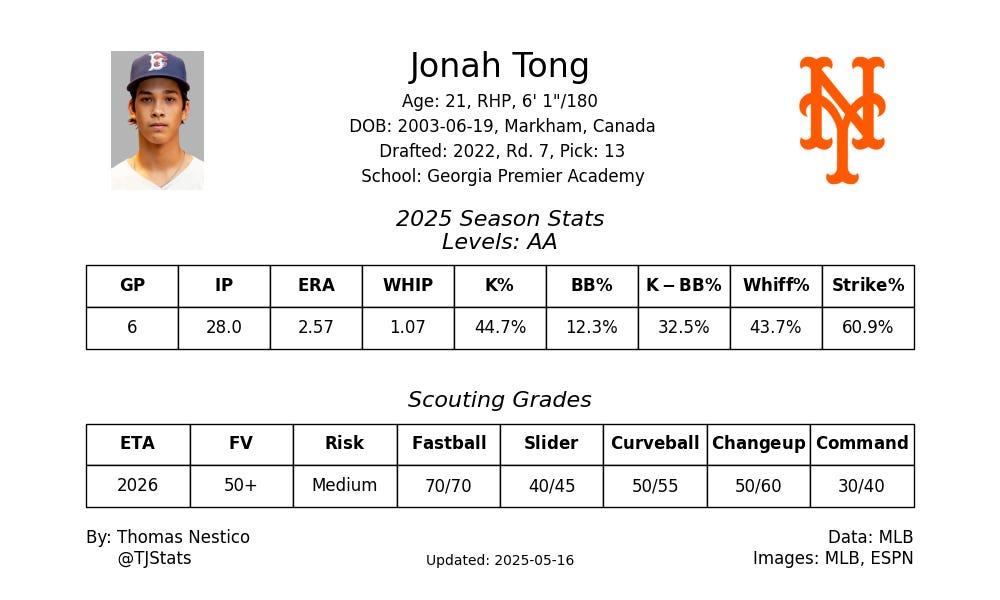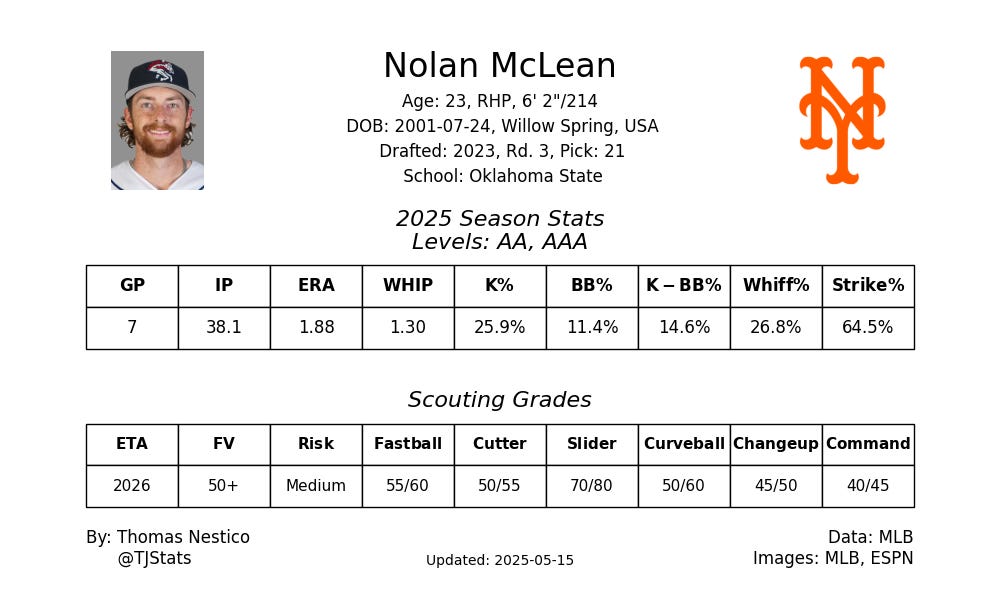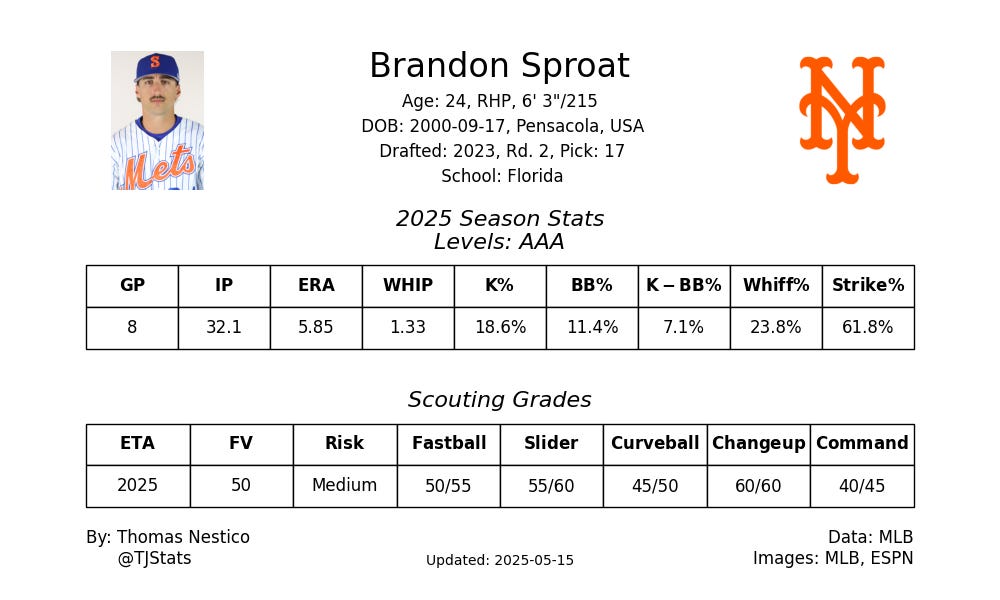In this article, I cover the Top 3 pitching prospects in the New York Mets pipeline and highlight their developments this season and their trajectory within the system.
Jonah Tong
Jonah Tong is striking out the world in AA this season while doing a fantastic job at limiting damage on all his offerings. His cut-fastball leads the way here thanks to the incredible ride on the pitch. This season it is averaging ~19" iVB while sitting 94-96 MPH, which is +2 MPH harder than in 2024. His over-the-top delivery is a massive driver into its high riding nature. Thanks to his smaller stature and above-average extension, he is able to get down to a ~6 ft vertical release point. The combination of massive ride from an unorthodox release aides in its effectiveness.
Tong's secondaries are a big point of discussion regarding his future as a starter. He has a wide array of them, including a changeup, curveball, slider, and a new cutter. The development of his changeup this season has been imperative to his success against LHH. It sits in the mid 80s, showcasing good velocity differential from his fastball. The biggest changes have come in its shape as it is showcasing a lot more depth as well as his feel of the pitch. He has been excellent with both its consistency and control, which has pushed it from a below average offering to plus. His curveball may be his most memorable pitch thanks to its massive vertical difference from his fastball. It sits at 76-78 MPH and can reach -20” iVB. That is over 3’ of separation from his fastball! He commands the pitch well, but there are concerns that the massive drop on the pitch in the mid 70s may not fool Major League hitters. Tong's slider and cutter are his least used offerings and for good reason. He doesn't have the greatest feel for them, and each exhibit subpar movement traits.
Control still seems to be the biggest hurdle for Tong as he is struggling to throw strikes and get ahead of batters early in the count. His stuff is untouchable and his gaudy whiff rates and strong damage mitigation metrics back it up, however his inability to generate chases keeps his walk rate well below average. His fastball will make him a stud bullpen arm in a pinch, but he needs more time to refine its command before being a mainstay in the Mets rotation.
Nolan McLean
Nolan McLean's development has been rather unprecedented. He was drafted as a two-way player out of Oklahoma State in 2023 and did not start pitching full-time until mid-2024. Not even a year later he finds himself in AAA and knocking at the door of the majors.
His ability to spin the ball is otherworldly as he can eclipse 3000 RPM on his breaking balls and generate a ton of movement at higher velocities. McLean's signature pitch is his mid 80s sweeper that can each up to 20" of glove-side movement. It is one of the few potential 80 grade offerings in MiLB. McLean wields a pair of fastballs, a sinker and a 4-Seamer, that each sit in the mid 90s. His sinker is his primary offering against RHH where its immense arm-side movement and slight deviation from his arm slot plays well on the inner third. He swaps his sinker for a 4-Seamer against LHH where its extremely flat approach fools batters high in the zone. McLean also tosses a gyro cutter/slider that lives in the high 80s. It's slight cutting action makes it effective damage mitigating offering against RHH. He rounds out his incredibly deep arsenal with a mid 80s changeup that generates above average depth with negative iVB.
McLean is exhibiting improved command this season and doing a formidable job at getting ahead of batters early. His development and combination of stuff, athleticism, command, and versatility, all in an abridged timeframe, makes him one of the most exciting pitching prospect in MLB. There were concerns that he was more suited for a bullpen role, but he quelled most of those worries with his performance thus far.
Brandon Sproat
There is no pitching prospect that has tanked their stock more this season than Brandon Sproat. After an electric 2024 which saw his storm through Hi-A and AA on the heels of fastball that hit triple digits, Sproat has struggled immensely since his promotion to AAA. After a trip to the development list cut last season short, it felt like a full winter to recover and build up would allow his elite velocity to return.
This was rather the opposite, as Sproat has yet to hit even 99 MPH with his fastball. Sproat cannot overcome his fastball's poor shape in this lower velocity band, which leaves it as an average offering. Due to this inefficiency, Sproat will likely be more effective as a sinkerballer, which would lead to a heavily depressed strikeout rate. From his low 3/4 slot, his sinker generates over 17" of arm-side run and helps jam RHH on the inner third. He doesn't generate many whiffs on the offering, but it has effectively limited damage this season. His changeup always flashed plus-plus potential thanks to his low 90s velocity and depth, but he is not seeing the same shape this season. The pitch closely resembles his sinker and has been hit much harder. Sproat's trio of breaking balls were also a highlight of his arsenal as it gave him plenty of options to mix and match his offerings, however the feel for each pitch seems to have degraded to the point that none are returning positive results.Along with all this negativity surrounding his arsenal, Sproat has seen his command falter this season. He is throwing his fastball and sinker in the strike zone at a below average rate, while leaving far too many of his secondaries over the plate.
There really is not much redeeming about Sproat's season thus far, and it is safe to say that he has been leapfrogged by multiple arms in the Mets system. The potential he flashed in 2024 gives me hope that he belongs as a Top 100 Prospect, but his results do not paint that picture.
Follow me on Twitter: @TJStats
Follow me on BlueSky: @tjstats.ca
Consider Supporting me on Patreon: TJStats





